Nucleophosmin is required for DNA integrity and p19Arf protein stability
- PMID: 16199867
- PMCID: PMC1265791
- DOI: 10.1128/MCB.25.20.8874-8886.2005
Nucleophosmin is required for DNA integrity and p19Arf protein stability
Abstract
Nucleophosmin (NPM) is a nucleolar phosphoprotein that binds the tumor suppressors p53 and p19(Arf) and is thought to be indispensable for ribogenesis, cell proliferation, and survival after DNA damage. The NPM gene is the most frequent target of genetic alterations in leukemias and lymphomas, though its role in tumorigenesis is unknown. We report here the first characterization of a mouse NPM knockout strain. Lack of NPM expression results in accumulation of DNA damage, activation of p53, widespread apoptosis, and mid-stage embryonic lethality. Fibroblasts explanted from null embryos fail to grow and rapidly acquire a senescent phenotype. Transfer of the NPM mutation into a p53-null background rescued apoptosis in vivo and fibroblast proliferation in vitro. Cells null for both p53 and NPM grow faster than control cells and are more susceptible to transformation by activated oncogenes, such as mutated Ras or overexpressed Myc. In the absence of NPM, Arf protein is excluded from nucleoli and is markedly less stable. Our data demonstrate that NPM regulates DNA integrity and, through Arf, inhibits cell proliferation and are consistent with a putative tumor-suppressive function of NPM.
Figures
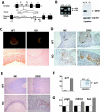
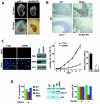
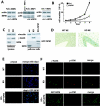
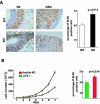
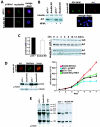
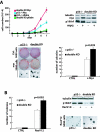
Similar articles
-
Ubiquitination of, and sumoylation by, the Arf tumor suppressor.Isr Med Assoc J. 2006 Apr;8(4):249-51. Isr Med Assoc J. 2006. PMID: 16671360
-
Delocalization and destabilization of the Arf tumor suppressor by the leukemia-associated NPM mutant.Cancer Res. 2006 Mar 15;66(6):3044-50. doi: 10.1158/0008-5472.CAN-05-2378. Cancer Res. 2006. PMID: 16540653
-
RNA aptamers interfering with nucleophosmin oligomerization induce apoptosis of cancer cells.Oncogene. 2009 Nov 26;28(47):4201-11. doi: 10.1038/onc.2009.275. Epub 2009 Sep 7. Oncogene. 2009. PMID: 19734942
-
p53-Dependent and -independent functions of the Arf tumor suppressor.Cold Spring Harb Symp Quant Biol. 2005;70:129-37. doi: 10.1101/sqb.2005.70.004. Cold Spring Harb Symp Quant Biol. 2005. PMID: 16869746 Review.
-
DNA damage, p14ARF, nucleophosmin (NPM/B23), and cancer.J Mol Histol. 2006 Sep;37(5-7):239-51. doi: 10.1007/s10735-006-9040-y. Epub 2006 Jul 20. J Mol Histol. 2006. PMID: 16855788 Review.
Cited by
-
Selective inhibitors of nuclear export show that CRM1/XPO1 is a target in chronic lymphocytic leukemia.Blood. 2012 Nov 29;120(23):4621-34. doi: 10.1182/blood-2012-05-429506. Epub 2012 Oct 3. Blood. 2012. PMID: 23034282 Free PMC article.
-
Evolutionarily conserved role of nucleostemin: controlling proliferation of stem/progenitor cells during early vertebrate development.Mol Cell Biol. 2006 Dec;26(24):9291-301. doi: 10.1128/MCB.01183-06. Epub 2006 Sep 25. Mol Cell Biol. 2006. PMID: 17000755 Free PMC article.
-
NPM phosphorylation stimulates Cdk1, overrides G2/M checkpoint and increases leukemic blasts in mice.Carcinogenesis. 2010 Feb;31(2):302-10. doi: 10.1093/carcin/bgp270. Epub 2009 Nov 23. Carcinogenesis. 2010. PMID: 19933706 Free PMC article.
-
Nucleophosmin: a versatile molecule associated with hematological malignancies.Cancer Sci. 2006 Oct;97(10):963-9. doi: 10.1111/j.1349-7006.2006.00270.x. Cancer Sci. 2006. PMID: 16984370 Free PMC article. Review.
-
Nucleophosmin serves as a rate-limiting nuclear export chaperone for the Mammalian ribosome.Mol Cell Biol. 2008 Dec;28(23):7050-65. doi: 10.1128/MCB.01548-07. Epub 2008 Sep 22. Mol Cell Biol. 2008. PMID: 18809582 Free PMC article.
References
-
- Bartek, J., C. lukas, and J. Lukas. 2004. Checking on DNA damage in S phase. Nat. Rev. Mol. Cell. Biol. 5:792-804. - PubMed
-
- Bartkova, J., Z. Horejsi, K. Koed, A. Kramer, F. Tort, K. Zieger, P. Guldberg, M. Sehested, J. M. Nesland, C. Lukas, T. Orntoft, J. Lukas, and J. Bartek. 2005. DNA damage response as a candidate anti-cancer barrier in early human tumorigenesis. Nature 434:864-870. - PubMed
-
- Borer, R. A., C. F. Lehner, H. M. Eppenberger, and E. A. Nigg. 1989. Major nucleolar proteins shuttle between nucleus and cytoplasm. Cell 56:379-390. - PubMed
-
- Borggrefe, T., M. Wabl, A. T. Akhmedov, and R. Jessberger. 1998. A B-cell-specific DNA recombination complex. J. Biol. Chem. 273:17025-17035. - PubMed
Publication types
MeSH terms
Substances
LinkOut - more resources
Full Text Sources
Other Literature Sources
Molecular Biology Databases
Research Materials
Miscellaneous
